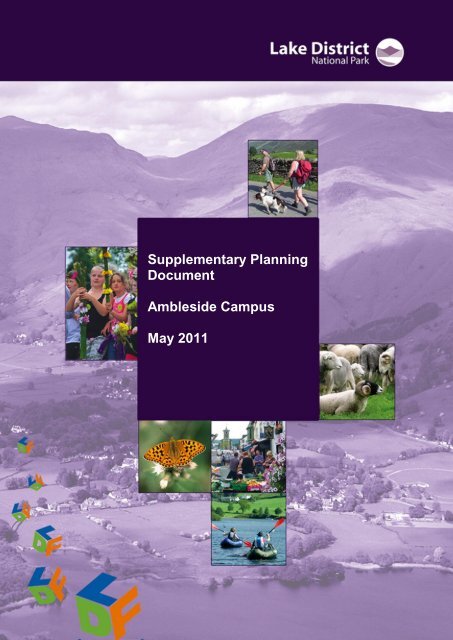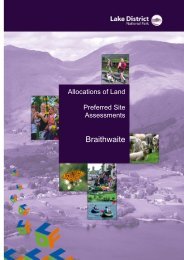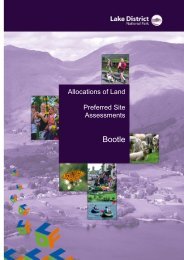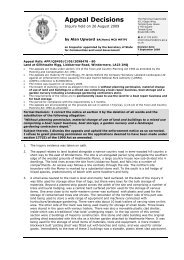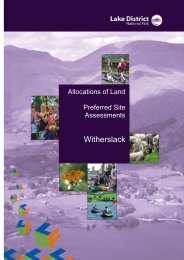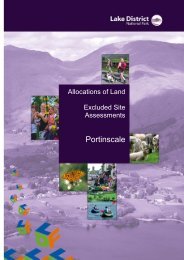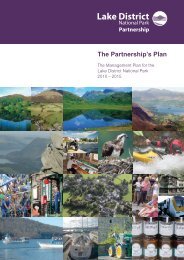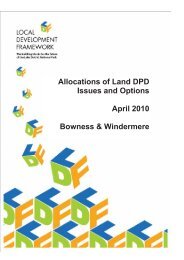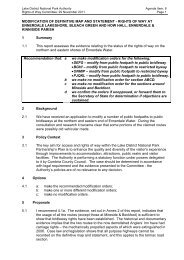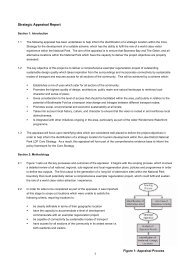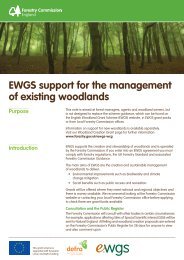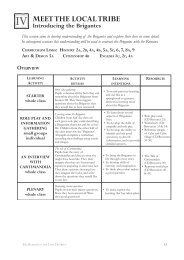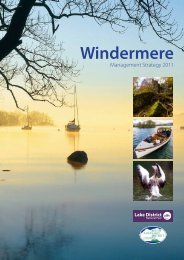Adopted Ambleside Campus Supplementary Planning Document
Adopted Ambleside Campus Supplementary Planning Document
Adopted Ambleside Campus Supplementary Planning Document
You also want an ePaper? Increase the reach of your titles
YUMPU automatically turns print PDFs into web optimized ePapers that Google loves.
<strong>Supplementary</strong> <strong>Planning</strong><br />
<strong>Document</strong><br />
<strong>Ambleside</strong> <strong>Campus</strong><br />
May 2011<br />
1
1 WHY DO WE NEED AN SPD?<br />
1.1 The Government advises in <strong>Planning</strong> Policy Statement 12 (Creating Strong,<br />
Safe and Prosperous Communities through Local Spatial <strong>Planning</strong>) that ‘A<br />
planning authority may prepare <strong>Supplementary</strong> <strong>Planning</strong> <strong>Document</strong>s (SPDs)<br />
to provide greater details on the policies of its development plan documents’.<br />
1.2 This SPD is for the <strong>Ambleside</strong> <strong>Campus</strong> - and by this we mean the three main<br />
sites (see Figure 1) of Scale How, Hill Top and Kelsick – which has been<br />
owned and operated by the University of Cumbria for the last 15 years. The<br />
University is continuing to operate from the Charlotte Mason building on the<br />
Scale How site. This SPD is for those areas of the Scale How site which the<br />
University no longer requires for its operations, together with Hill Top and<br />
Kelsick.<br />
1.3 The SPD enables a strategic approach to be taken to the future use of the<br />
campus, and aims to maximise environmental, economic and social benefits in<br />
the interests of the Lake District National Park and the local community. It<br />
also provides certainty for prospective developers as to the Lake District<br />
National Park Authority’s expectations and requirements.<br />
1.4 Specifically, the SPD provides guidance on, and interpretation of, the<br />
implementation of the Lake District National Park Local Development<br />
Framework Core Strategy Policies CS07 (Central and South East Distinctive<br />
Area) and CS19 (Community, health and education facilities). The priority is<br />
to deliver sustainable Further or Higher Education. The SPD outlines<br />
alternative land uses, but makes clear that these should only be considered<br />
when all viable options for education have been exhausted in accordance<br />
with a marketing campaign. Its focus is on the development principles that<br />
will underpin any future use.<br />
1.5 Public consultation on the SPD took place between 7 February and 18 March<br />
2011. A summary of the responses is available on<br />
www.lakedistrict.gov.uk/amblesidecampus<br />
1.6 The SPD is intended to assist with the creation of a marketing strategy and<br />
should have the purpose of securing a use / operator in line with that sought<br />
by the SPD. The marketing strategy will be produced by / on behalf of the<br />
University of Cumbria guided by the LDNPA. Both this SPD and the<br />
marketing strategy, when available, should be read alongside one another.<br />
2 THE AMBLESIDE CAMPUS - A BRIEF DESCRIPTION<br />
2.1 The <strong>Ambleside</strong> <strong>Campus</strong> is located to the north west and north east of<br />
<strong>Ambleside</strong>. The total area extends to over six hectares, and includes both<br />
developed land and open space.<br />
2.2 The campus comprises 3 principal sites: Scale How (the former Charlotte<br />
Mason college site), Hill Top, and Kelsick (see Figures 1 and 2).<br />
2.3 References throughout the document to Scale How are intended to mean the<br />
whole site rather than the building unless specified.<br />
2
2.4 The main Scale How site is approximately 5.1 hectares and 0.2 miles from<br />
the centre of <strong>Ambleside</strong>. The campus is bounded to the east by Nook Lane<br />
and west by Greenbank Road. Access to the site is from Nook Lane and<br />
Rydal Road (southern boundary). The site is made up from a variety of<br />
buildings many of which reflect the locally distinctive architectural style. The<br />
campus sits within extensive, and steeply sloping, grounds planted with<br />
mature trees and shrubs.<br />
2.5 Scale How itself, the former Charlotte Mason College, is at the centre of the<br />
site. Scale How was established as a training school in the 1890s by<br />
Charlotte Mason, who became an internationally renowned pioneer in childcentred<br />
education. The Armitt Museum and Library which houses the<br />
Charlotte Mason archive are within the Scale How campus site and currently<br />
under lease.<br />
2.6 Whilst the majority of existing buildings on Scale How are in education use,<br />
six cottages (Ashfield, Beechfield, Heathfield, Hazeldene and Greenbank<br />
North and Greenbank South) are in residential use.<br />
2.7 At the present time, the University continues to occupy part of the Scale How<br />
site. Its operations have been scaled back to the former Charlotte Mason<br />
Library which will continue to provide the focus for the University of Cumbria’s<br />
activities on the <strong>Ambleside</strong> campus.<br />
2.8 The current use of the University’s site is for undergraduate students of<br />
outdoor studies, and a smaller number of leadership and enterprise<br />
programmes. These together comprise approximately 100 Full Time<br />
Equivalent students which will rise to 120 Full Time Equivalent students in<br />
2011 / 2012 when a full cohort will spend their second year at <strong>Ambleside</strong>.<br />
2.9 The University of Cumbria has a small number of academic and professional<br />
service staff based at the <strong>Ambleside</strong> campus supporting the students, and the<br />
student services and security required for the building. There will be room<br />
within the University’s site to accommodate short courses and enterprise<br />
activities and some related post graduate studies. This will include<br />
international programmes, for example the University runs a business<br />
programme in partnership with Robert Kennedy College, Zurich, with students<br />
spending one semester in <strong>Ambleside</strong>.<br />
2.10 The Charlotte Mason building will also be available for conferences and will<br />
allow local students to access University resources online. The building also<br />
houses the Mountain Heritage Trust collection.<br />
2.11 Hill Top is approximately 0.47 hectares and 0.2 miles from the centre of<br />
<strong>Ambleside</strong>. The site is located to the east of the main <strong>Campus</strong> and is<br />
enclosed on all sides, to the west by Sweden Bridge Road and to the south<br />
by Kirkstone Road. The north and east boundaries are fronted by residential<br />
dwellings. The site is occupied by a large house - in the 1800s a girls’<br />
boarding academy, and much more recently used for outdoor education<br />
training with twentieth century extension and out-buildings. The rest of the<br />
site is reasonably flat. Access is via Kirkstone Road. There are wide lawns<br />
and planting to the front of the property and limited parking within the campus.<br />
3
2.12 Kelsick is approximately 0.97 hectares and 0.5 miles from the centre of<br />
<strong>Ambleside</strong>. The site accommodates two principal buildings, including the<br />
former Kelsick Grammar School, opened in 1907. Access is via Stockghyll<br />
Lane.<br />
4
Figure 1. <strong>Ambleside</strong> <strong>Campus</strong> showing the boundaries of the Scale How, Hill<br />
Top and Kelsick sites.<br />
5
Figure 2. Scale How and Hill Top site showing the <strong>Ambleside</strong> Conservation<br />
Area boundary, listed buildings and designated open space.<br />
6
3 THE CASE FOR SUPPORTING CONTINUED EDUCATIONAL USE.<br />
Policy context<br />
3.1 The Lake District National Park Local Development Framework Core Strategy<br />
aims to foster balanced and sustainable communities meeting the needs of<br />
all, including its young people.<br />
3.2 The Core Strategy, which was adopted in October 2010, sets out a clear<br />
policy for the continuing educational use of the <strong>Ambleside</strong> campus:<br />
‘We will support the University of Cumbria, as we recognise that it<br />
brings community benefits for the National Park. We will maintain the<br />
university campus at <strong>Ambleside</strong> and work with partners to support the<br />
on-going provision of undergraduate and postgraduate training courses<br />
at the <strong>Ambleside</strong> campus.’<br />
Extract from Core Strategy Policy CS07 (Central and South East Distinctive Area)<br />
3.3 This strategic decision is strengthened by Core Strategy Policy CS19<br />
(Community, Health and Education Facilities) which, at a strategic level,<br />
states that:<br />
‘We will protect existing community, education and health facilities from loss<br />
or change of use, unless there is evidence to demonstrate that there is no<br />
longer a local community need for the facility, or that the facility is no longer<br />
suitable or viable for a local community use’.<br />
3.4 The Lake District National Park Partnership’s Plan (the Management Plan for<br />
the Lake District National Park 2010-2015) also spells out its commitment to:<br />
‘retain educational uses alongside other appropriate enterprises for the<br />
University of Cumbria’s <strong>Ambleside</strong> <strong>Campus</strong>’ (Prosperous Economy Action<br />
6.15).<br />
3.5 Development should complement and reinforce the National Park’s special<br />
qualities. We will, therefore, encourage design excellence and require<br />
development to be based on sustainable development principles (Local<br />
Development Framework Core Strategy Policies CS10 (Achieving Design<br />
Excellence), CS11 (Sustainable Development Principles). <strong>Planning</strong> Policy<br />
Statement 5 (<strong>Planning</strong> for the Historic Environment) and associated guidance<br />
will assist in the assessment of the site’s key characteristics and significance<br />
of its setting.<br />
Other Contextual Issues<br />
3.6 We are required, by Government, to take account of the wider context in the<br />
development of National Park policies, and have regard to sub-regional<br />
policies including those of local Community Strategies.<br />
3.7 The importance of educational opportunities for Cumbria’s young people is<br />
reflected in:<br />
7
• The Cumbria Economic Strategy (2009-2019) refers, for example, to a<br />
once-in-a-generation opportunity to transform Cumbria’s Education, Skills<br />
and Research.<br />
• The Cumbria Community Strategy’s vision for strong, safe and inclusive<br />
communities states that ‘young people have an important part to play in<br />
Cumbria’s future and they will be provided with excellent learning and<br />
training opportunities to help them achieve’. The Strategy says that by<br />
2028 Cumbria will be a place where children and young people, in<br />
particular, will be empowered to get involved in their communities and<br />
provided with excellent education and training provision, and lifelong<br />
learning opportunities;<br />
3.8 The rationale for supporting continued educational use of the <strong>Ambleside</strong><br />
campus is the benefits that the student population brings to the local<br />
community: changing the demographics, diversifying the need and demand<br />
for goods and services, and bringing money into the local economy (LDNP<br />
Local Development Framework Core Strategy Technical Reports 1,2,3).<br />
Surveys consistently show that young people are under-represented in the<br />
Lake District National Park.<br />
3.9 The presence of an additional Further Education (FE) and / or Higher<br />
Education (HE) provider in <strong>Ambleside</strong> doesn’t just benefit the area<br />
economically by meeting the demands and needs of the students it brings, or<br />
the employment such an establishment offers, although these community<br />
benefits are significant. It helps to diversify the economy and can produce a<br />
skilled workforce for a wide range of business and industry.<br />
A New Opportunity for Education<br />
3.10 Core Strategy Policy CS07 seeks ongoing provision of undergraduate and<br />
postgraduate courses on the <strong>Ambleside</strong> <strong>Campus</strong>, which essentially fall into<br />
two categories – Further and Higher Education:<br />
Further Education: Education below the level of a university degree for<br />
people who are older than school age<br />
Higher Education: Education at a college or university where subjects are<br />
studied at an advanced level<br />
(Source: http://dictionary.cambridge.org)<br />
3.11 The Lake District National Park Authority is committed to supporting providers<br />
who can support Further and Higher Educational activities on the campus.<br />
3.12 All of the following forms of education are potential opportunities for the<br />
<strong>Ambleside</strong> campus and should be fully explored in so far as they fall within<br />
the definition of providing HE or FE education:<br />
• Degree level / certificated courses<br />
• Vocational / non-vocational<br />
• Courses linked to businesses / skills pertinent to the economy of the Lake<br />
District National Park, such as hospitality and climate change<br />
• Courses which build upon the special qualities of the National Park, such<br />
as landscape, biodiversity and environmental issues<br />
• Courses which link to new forms of enterprise for the National Park<br />
8
3.13 Opportunities for joint ventures, including multi-partnership arrangements with<br />
public and private operators, professional and academic bodies (including<br />
other educational charities such as the Field Studies Council, the Kelsick<br />
Educational Foundation and local colleges) should also be investigated, as<br />
long as they do not compete directly with the University of Cumbria’s<br />
business in <strong>Ambleside</strong>.<br />
3.14 The University of Cumbria works with partners across its portfolio of courses,<br />
enterprise and research activities. It is in partnership with Further Education<br />
colleges to validate programmes of study and to foster progression<br />
opportunities into Higher Education. The University also has connections with<br />
professional education, health and social care partners in other parts of the<br />
county, and in Lancashire and London. These partners support the delivery<br />
of the University’s courses through placement learning.<br />
3.15 The University has a network of sites across Cumbria and North Lancashire -<br />
Carlisle, Lancaster, <strong>Ambleside</strong>, Newton Rigg, Lillyhall and Barrow - to provide<br />
as many people as possible with opportunities to access a higher level of<br />
study.<br />
3.16 In <strong>Ambleside</strong>, the University is interested in any partnerships which will help<br />
to foster the special qualities of the campus including its historic and<br />
environmental assets, and which will support the connection with the local<br />
community.<br />
Site Flexibility<br />
3.17 The Lake District National Park Authority’s priority is to secure continued<br />
educational use of the Scale How campus site, beyond the continued<br />
provision offered by the University of Cumbria, before consideration can be<br />
given to alternative potential uses for the site.<br />
3.18 As already identified, the scope of this document is to focus on all three main<br />
elements of the <strong>Ambleside</strong> campus, formerly operated together by the<br />
University of Cumbria as a single establishment.<br />
3.19 Core Strategy Policy CS07 - which explicitly states the Authority’s position on<br />
the <strong>Ambleside</strong> campus - does not differentiate between the main operation at<br />
Scale How, and the ‘satellite’ bases of Hill Top and Kelsick. As such, all<br />
benefit from the same level of protection by policy against change of use to<br />
non-educational uses.<br />
3.20 However, it is recognised that Hill Top and Kelsick have both, over time, been<br />
acquired through evolution to become part of the educational operation based<br />
at the main Scale How site. Whilst these satellite sites increase the capacity<br />
and facilities available to an education provider, it is equally apparent that a<br />
different operator may not require Hill Top and Kelsick and may instead wish<br />
to operate solely from Scale How. In this case, the use of the Hill Top and/or<br />
Kelsick sites independently from Scale How is likely to be unsustainable for<br />
educational uses.<br />
3.21 Notwithstanding this, alternative uses for these satellite sites should not be<br />
pursued until such time that an educational re-use has been secured on the<br />
9
Scale How site, and until it has been confirmed by the operator that these<br />
sites are not required. It would be inappropriate and undesirable to sever the<br />
links between the three sites prematurely, thereby potentially limiting the<br />
desirability or sustainability for educational providers.<br />
3.22 This same principle applies to the halls of residence on Rydal Road; whilst<br />
these sites fall outside of the scope of this document, opportunities for their<br />
change of use should not be pursued until an educational re-use at Scale<br />
How has been secured, and there is clarity as to whether the operator<br />
requires this type of student accommodation. This is a material consideration<br />
which is capable of being attributed significant weight in the determination of<br />
any application for change of use.<br />
Positive Marketing Campaign<br />
3.23 We will seek to agree the content of a marketing strategy with the University<br />
of Cumbria, or any other vendor of the sites. This will define the scope of the<br />
marketing campaign and assist in determining the content of any marketing<br />
material such as advertisements and agents’ brochures.<br />
3.24 The marketing campaign will be positive and pro-active, highlighting the<br />
advantages of having an educational facility in the heart of the Lake District<br />
National Park on a site which has operated, as an educational institution in<br />
differing forms, for over a century. The marketing material would be able to<br />
draw attention to the potential strategic economic and community benefits of<br />
a continuing educational facility in <strong>Ambleside</strong>, together with the supportive<br />
planning policy context.<br />
3.25 A marketing strategy for the <strong>Ambleside</strong> campus would be expected to:<br />
Market <strong>Ambleside</strong> and the campus as a base for Higher and / or Further<br />
Education<br />
Make explicit reference to existing facilities on the <strong>Ambleside</strong> campus<br />
(different sites, and building sizes and types which allow for different<br />
educational uses which support and / or complement the University’s<br />
current and planned provision, supporting facilities, and accommodation<br />
for students and staff) together with the indicative student capacity of the<br />
whole campus with outlying halls of residence.<br />
Show that the potential exists for partnership arrangements which may<br />
complement and support the existing partnership arrangements enjoyed<br />
by the University<br />
Outline key dates, including the submission of proposals, and submission<br />
requirements, contact details and so on.<br />
If a minimum or guide price is specified, it should be based on the provisions<br />
for education set out in this <strong>Supplementary</strong> <strong>Planning</strong> <strong>Document</strong>. The<br />
specification or otherwise of a guide price should not preclude discussion,<br />
with interested parties, about leasing options.<br />
3.26 A critical component of any marketing strategy is advertising, and the<br />
following publications would be particularly appropriate:<br />
10
The Times Educational Supplement, Times Higher Educational<br />
Supplement, and one other leading national newspaper<br />
The Institute for Outdoor Learning’s journal ‘Horizons’<br />
International media such as newspapers, journals and / or websites<br />
3.27 Further advice could be sought, by interested parties, from Cumbria Tourism<br />
and specialists in the hospitality and outdoor education sectors, on the<br />
potential for hospitality-training and / or outdoor education opportunities.<br />
3.28 The Lake District National Park Authority will support the vendor in their<br />
consideration of expressions of interest to maximise the confidence of all<br />
parties and satisfy the expectations of this SPD.<br />
4 MIXED USE: EDUCATION TOGETHER WITH OTHER USES<br />
4.1 Given the current economic climate, we acknowledge that it may prove<br />
impossible to expand educational provision further on the <strong>Ambleside</strong> campus<br />
in a way that would be sustainable in the long term.<br />
4.2 If this proves to be the case, and all educational options alone have been<br />
explored and proved to be unsustainable, then a mix of education and other<br />
use(s) would be acceptable in principle, providing it can be demonstrated that<br />
the other use(s) helps to facilitate the establishment of education, and is in<br />
accordance with adopted development plan policy.<br />
4.3 We may use planning obligations or conditions to secure educational use in<br />
this scenario.<br />
5 OTHER DEVELOPMENT OPPORTUNITIES<br />
5.1 Similarly, only after all educational uses, and then a mix of education and<br />
other uses , have been explored and proved to be unsustainable, will we<br />
consider other - non-educational - development opportunities.<br />
5.2 We will scrutinise the robustness of the marketing strategy and its component<br />
parts for full educational, and mixed education uses. In assessing the<br />
evidence, we will have regard to the principles outlined in the marketing<br />
section of this SPD and such information as:<br />
• Details of individuals, organisations, and other educational institutions<br />
contacted (names, position held, responsibilities, examples of current<br />
services provided)<br />
• Minutes of meetings (including potential educational uses, possible<br />
partnership arrangements)<br />
• Details of advertising – where, when and how advertisements have<br />
been placed – together with comprehensive details and records of all<br />
negotiations including agreed minutes of all meetings<br />
• Details of the vendor’s own criteria applied during the marketing<br />
and/or tender process and the justification for these.<br />
5.3 The following sections indicate uses identified as a priority for the National<br />
Park as a whole, the Central and South East Distinctive Area, and Rural<br />
Service Centres which include <strong>Ambleside</strong>. For each site, we have outlined<br />
11
the constraints and indicated, without prejudice, the potential development<br />
opportunities.<br />
6 SCALE HOW SITE<br />
Core Strategy Priority Uses:<br />
Residential (local needs and local affordable needs housing, supported<br />
by Core Strategy Policies CS02 Achieving Vibrant and Sustainable<br />
Settlements and CS18 Housing Provision)<br />
Office / business (supported by Core Strategy Policies CS02 Achieving<br />
Vibrant and Sustainable Settlements and CS22 Employment)<br />
Community facilities (supported by Core Strategy Policies CS02<br />
Achieving Vibrant and Sustainable Settlements, CS19 Community,<br />
Health and Education Facilities, CS21 Open Space and Recreation)<br />
Key Opportunities<br />
Promotion of a wider mix of uses including residential, employment and<br />
hotel uses through the adaptive re-use of existing buildings and<br />
redevelopment of others in the context of the Conservation Area<br />
The demolition or replacement of certain relatively modern extensions,<br />
and buildings which are of little architectural merit, which detract from the<br />
setting of the listed buildings to which they relate.<br />
The reduction or relocation of car parking from the front of Scale How in<br />
order to enhance its setting.<br />
Creation of new public spaces for amenity and recreation.<br />
Improvement of the quality of the hard and soft landscaping.<br />
Creation of an exemplar project with minimal car parking provision,<br />
because of the site’s proximity to the centre of <strong>Ambleside</strong>.<br />
Improvement of pedestrian and cycling routes in and around the site.<br />
Enhancement of wildlife habitats<br />
Key Constraints / Issues<br />
Listed buildings and their settings: Scale How (Grade II). The design and<br />
scale of any new build would need to be sympathetic to Scale How and its<br />
setting. The open area in front of the building is particularly important.<br />
Nook Cottage on Nook Lane. This is a residential property, in separate<br />
ownership, immediately adjacent to the site. Any redevelopment will need<br />
to have regard to residential amenity.<br />
Conservation Area: The southern part of the Scale How site is within the<br />
Conservation Area. There is a need for the sympathetic design and<br />
scale of any new build.<br />
Trees: There are no Tree Preservation Orders but those trees in the<br />
Conservation Area are given additional protection. The grounds contain<br />
numerous mature specimen trees and others which have individual and<br />
group value.<br />
Historic Environment Record (HER). The former quarry, adjacent to the<br />
Charlotte Mason Library, is on the HER<br />
Defined amenity open space (Local Plan BE18 and Core Strategy CS21).<br />
12
Extant policy protects existing open spaces and recreational facilities.<br />
Development on the defined amenity open space will not be supported.<br />
Access into and within the site, particularly if a range of separate uses<br />
are ultimately proposed.<br />
There may be protected species, such as bats, in existing buildings on<br />
site.<br />
7 HILL TOP<br />
Core Strategy Priority Uses<br />
Residential and / or residential institution (local needs and local<br />
affordable needs housing, supported by Core Strategy Policies CS02<br />
Achieving Vibrant and Sustainable Settlements and CS18 Housing<br />
Provision) or elderly care / nursing facility supported by Core Strategy<br />
Policy CS19 Community, Health and Education facilities).<br />
Office / business (supported by Core Strategy Policies CS02 Achieving<br />
Vibrant and Sustainable Settlements and CS22 Employment)<br />
Key Opportunities<br />
Replacement of the twentieth century extensions and additions with<br />
development more sympathetic to the original build.<br />
Improvement of hard and soft landscaping surrounding the buildings<br />
Key Constraints / Issues<br />
The site sits within the <strong>Ambleside</strong> Conservation Area<br />
Surrounding domestic properties<br />
8 KELSICK<br />
> There are no priority uses identified for the Kelsick site within the Core<br />
Strategy<br />
8.1 The original buildings at the Kelsick site are of historic and cultural interest,<br />
and are worthy of retention, secured by an appropriate re-use. We have not<br />
identified priority uses because of the site’s location and highways access.<br />
8.2 However, this does not imply that there are no acceptable uses: Policy CS02,<br />
for example, allows the appropriate reuse or redevelopment of existing<br />
buildings in the open countryside.<br />
8.3 Other Core Strategy policies expand on how ‘appropriateness’ is assessed on<br />
a case-by-case basis and that uses such as housing and employment are<br />
potentially capable of support. Undoubtedly, however, the nature of the<br />
highways access to the site will be a significant material consideration.<br />
13
Local Development Framework<br />
Spatial <strong>Planning</strong> & Communities Team<br />
Lake District National Park Authority<br />
Murley Moss<br />
Oxenholme Road<br />
Kendal<br />
Cumbria LA9 7RL<br />
Tel: 01539 724555<br />
Fax: 01539 740822<br />
Email: ldf@lake-district.gov.uk<br />
www.lake-district.gov.uk/ldf<br />
14


